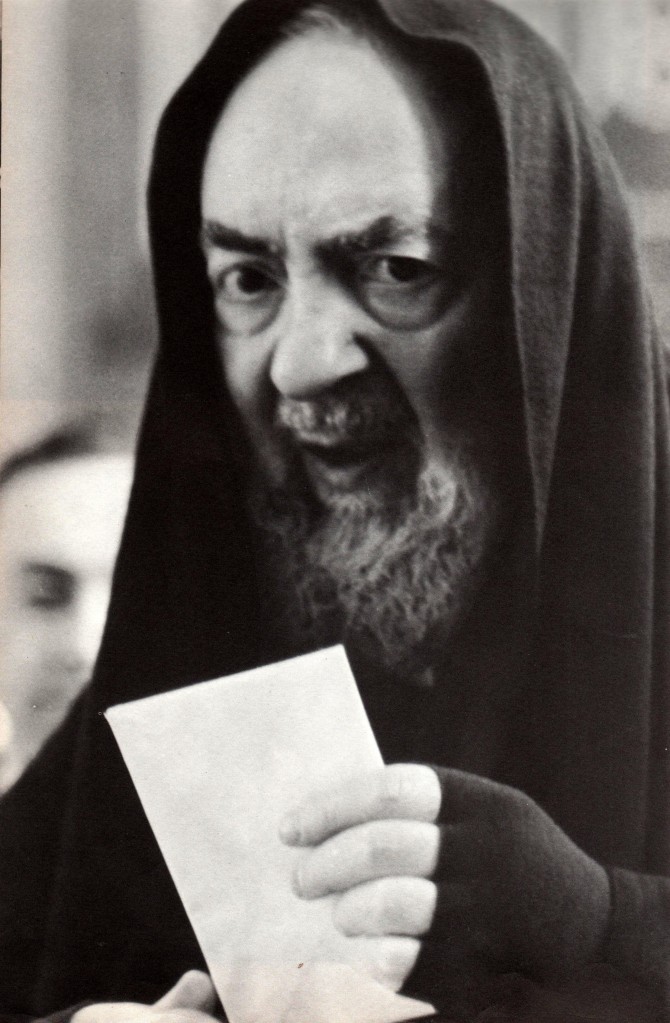Just a reflection?
..jpg)
Last Thursday (2/11/15), relics of the great Saint Padre Pio -- including his encased body -- left the Vatican after a six-day journey in various parts of Rome, part of the Jubilee Year of Mercy. It was Pope Francis himself, of course, who authorized the relics to be circulated (they were seen by an estimated 500,000), and the Holy Father himself prayed with a Padre Pio prayer group at the start of the exhibition (which may allay fears from traditionalists that the current Pontiff is straying from such veneration, as perhaps also will his obvious devotion to the Blessed Mother, seen most recently at Guadalupe).
Whatever the case, the point is that Pope Francis had of late been in close proximity to the incredible, wonder-working saint (who so often had
been seen in bi-location), and so it was galvanizing to receive a screenshot of
television coverage on Friday (coincidentally, the day after Pio's relics left Rome), that bore
a startling reflection resembling the great saint in cowl and Franciscan robe.
The remarkable reflection [see above] was just behind the Patriarch of the Russian Orthodox Church as he and Francis embraced in Cuba in what virtually all commentators saw as a historic event. It was the first time in 1,000 years that the leaders of the two huge denominations of Christianity have met and has the potential for setting in motion a lessening of the Great Schism that for so long has painfully divided Christianity.
Was Padre Pio behind it (literally)? Or at least with the Holy Father? Did he "accompany" the Pope from Italy to Cuba (and perhaps now Mexico)?
The photo -- coming to us immediately after the meeting -- seemed too immediate to be a hoax ("photo-shopped"). But one always qualifies. As in so many cases, it is open to interpretation and "explanation." Questioning is healthy, as long as it does not negate faith. Was it Pio, or the reflection of a clerical Orthodox attendant behind the scenes and camera? Perhaps a refraction of light that somehow caught a distorted image of the Patriarch himself -- who also wears a cowl, robe, and beard, as did the saint?
 There is always room for doubt, as there is frequently an
element of the natural in the supernatural (and vice versa). We'll leave it as
it is. But when it comes to the supernatural,
let us above all be open, recalling, perhaps, something a Catholic named Antonin Scalia once said
about skeptics and miracles (this
Harvard-educated, revered jurist, during a talk in 2014 to the St. Thomas More
Society of Maryland). "Although the sophisticated may deride
them as simple-minded, committed Christians should have the courage to embrace
their faith. It isn't irrational to accept the testimony of eyewitnesses to
miracles.
There is always room for doubt, as there is frequently an
element of the natural in the supernatural (and vice versa). We'll leave it as
it is. But when it comes to the supernatural,
let us above all be open, recalling, perhaps, something a Catholic named Antonin Scalia once said
about skeptics and miracles (this
Harvard-educated, revered jurist, during a talk in 2014 to the St. Thomas More
Society of Maryland). "Although the sophisticated may deride
them as simple-minded, committed Christians should have the courage to embrace
their faith. It isn't irrational to accept the testimony of eyewitnesses to
miracles.
"What is irrational is to reject a priori, with no investigation, the possibility of miracles in general and of Jesus Christ's resurrection in particular -- which is, of course, precisely what the worldly wise do.
"Why wasn't that Church absolutely packed with nonbelievers, seeking to determine if there might be something to this?" this now-deceased law expert (a judge, let us remember!), asked his audience, referring to reports years back of weeping statues and a stigmatic priest at a church in Maryland. The answer was obvious, Justice Scalia said (with a bit of disdain): "The wise do not investigate such silliness. Surely those who adhere to all or most of these traditional Christian beliefs are regarded in the educated circles that you and I travel in as, well, simple-minded." He added that Christian fundamentalists had been described by a story in the Washington Post as poorly educated and easily led. The same attitude applies, of course, to traditional Catholics who do such positively peasant-like things as saying the Rosary, kneeling in adoration before the Eucharist, going on pilgrimages to Lourdes or Medjugorje and -- worst of all -- following indiscriminately, rather in smorgasbord fashion, the teachings of the Pope."
Unfortunately, some of the sharpest skepticism comes from those who work in diocesan offices, teach theology at Catholic colleges (and seminaries), or operate Catholic blogsites and media. Whatever the case with this reflection of "Pio" (perhaps a hoaxer will suddenly erupt onto the scene, though we doubt it), it is hard to reconcile the current climate of skepticism with the miracles of the New and Old Testaments. In some circles, this Christian resistance to notion of the supernatural might be called "cognitive dissonance."
Is it always just a refraction of light, just a distorted shadow, just a reflection?
[see also: article in The Mystic Post and Saint Pio relics leave Vatican]
[And: The Justice and Catholicism, What he thought of the Pope, and Scalia believed in devil]
[resources:
The God of
Miracles]
Spirit Daily on Twitter
Facebook
Donations: we need and appreciate them!
